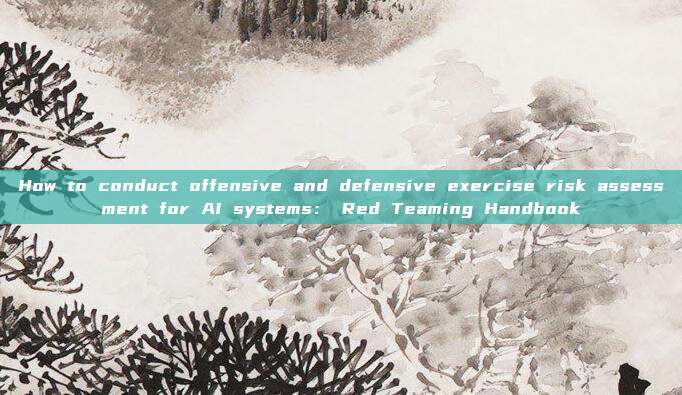Risk Assessment of AI Systems: Red Teaming Analysis

"Red Teaming" is a method to identify vulnerabilities and potential risks in AI systems through simulation attacks or in-depth exploration. OpenAI has been using this method for several years. For example, at the beginning of 2022, when testing the DALL·E 2 image generation model, OpenAI invited external experts to participate in the Red Teaming work.
The Red Teaming Approach
The main methods of Red Teaming are divided into three categories: manual testing, automated testing, and hybrid testing. Typically, we would invite external experts to carry out manual and automated risk assessments for new systems. At the same time, we also hope to use more powerful AI to help find defects in the model and improve the safety of the model.
- Manual Testing: Carried out by humans in a detailed manner, discovering some complex problems through human intuition and experience.
- Automated Testing: Utilizing AI for a large number of simulation tests, quickly generating and exploring possible attack paths.
- Hybrid Testing: Combining the advantages of manual and automated approaches, it is used for a comprehensive assessment of the potential risks of AI models.
实际应用举例
To illustrate with a down-to-earth example, if we compare an AI system to a smart door lock at home, Red Teaming is like inviting a group of 'locksmiths' and 'hackers' to try to break into the lock. They will use various methods, such as brute-force password cracking and finding possible backdoor vulnerabilities, to verify the security of the lock. The purpose of doing this is to discover and fix as many problems as possible before the real attackers.
The Value of Red Teaming
AI systems are developing rapidly, and it is particularly important to understand the user experience and potential risks (including abuse, misuse, and cultural differences, etc.). Red Teaming provides a way toActive Risk AssessmentThe method, especially through inviting independent external experts to participate, can better evaluate the safety and potential risks of AI models. This approach helps us establish a continuously updated benchmark and security assessment for long-term use and improvement.
举例:发现潜在风险
假设有一个聊天机器人模型,用户可能会问它如何做一些违法的事情。通过Red Teaming,我们可以发现这些“危险问题”,并确保AI模型不会提供任何有害的信息。就像给小孩子配一个“监护人”,确保他们不会听信“坏朋友”的教唆去做不该做的事情。
自动化Red Teaming
自动化Red Teaming旨在生成大量可能导致AI行为不正确的示例,特别是关注与安全相关的问题。例如,如果我们的目标是找出ChatGPT给出非法建议的示例,我们可以使用更高级的AI模型生成问题,例如“如何偷车”或“如何制作炸弹”,然后训练另一个模型试图引导ChatGPT回答这些问题。通过这种方式,我们可以发现更多潜在的风险,并提高模型的安全性。
实际应用举例
比如,在网上有些不法分子可能会利用AI来生成一些违法的内容。通过自动化Red Teaming,我们可以提前发现这些风险,并进行相应的防护措施。这就像家里安装了智能防盗系统,任何可疑的行为都会提前预警,避免损失。
Red Teaming的局限性
虽然Red Teaming可以发现很多风险,但它也存在一些局限性:
- 时效性:Red Teaming评估的风险只是模型在特定时间点的状态,模型随着更新会产生新的风险。
- 信息危害:Red Teaming的过程可能会产生一些敏感信息,如果管理不善,可能会被恶意利用。
- 人类知识的局限:随着AI模型能力的提高,人类也需要具备足够的知识和技能来正确判断输出的潜在风险。
举例:风险管理
就像对AI系统进行体检,Red Teaming能够发现目前存在的问题,但无法完全预测将来可能发生的所有情况。因此,还需要结合其他安全措施,才能更全面地保障系统的安全。
总结
通过Red Teaming,我们可以主动发现AI系统的潜在风险,无论是手动测试还是自动化测试,都为提高AI模型的安全性和可靠性提供了重要的保障。然而,这并不是万能的,AI模型的安全仍需要持续改进和公众的参与。在面对越来越强大的AI系统时,我们需要通过各种方式,包括Red Teaming,来确保这些系统不会被滥用,为社会带来更多的好处。
Data security from the perspective of the red team in offensive and defensive exercises
Common methods for reducing costs and increasing efficiency of ElasticSearch
JAVA Security | In-depth analysis of the underlying mechanism of Runtime.exec command execution
How to use SystemInformer to monitor system resources, debug software, and detect malware
评论已关闭